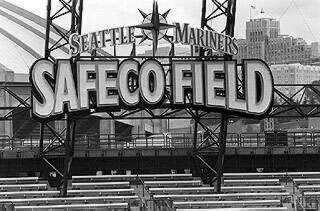|
Subscribe / Renew |
|
|
Contact Us |
|
| ► Subscribe to our Free Weekly Newsletter | |
| home | Welcome, sign in or click here to subscribe. | login |
This Century's Top Ten Construction Projects
|
|
It struck out at the polls, but fans of Safeco Field still claim victory
Dates: 1997-1999
Safeco Field was never supposed to be, at least not according to a slim majority of King County voters. They narrowly rejected a plan to build the stadium with the retractable roof, but the project was snatched from the ash heap by the state Legislature. That was the first hurdle. The second was the tight timeline contractors had to race against. When work began, crews knew they had to build a Major League Baseball stadium in just 34 months. Typically, it takes 50 months.
Hunt-Kiewit, the contractor that was a joint venture of two companies, found deliverance in tower cranes. Unlike conventional or mobile cranes, tower cranes offer several advantages. They have faster swing speed and line speed. Plus, the heights of the towers varied so the lines overlapped without colliding. And tower cranes take up less room and don't have to be moved as do their conventional counterparts. "We covered the entire job site with these four cranes," said J.C. Brummond, stadium project manager. Brummond is with Kiewit Construction. His counterpart from Huber, Hunt & Nichols was Dennis Gilbert, the Safeco Field project director.
Hemmed in by railroad tracks on one site and busy streets and buildings on the other three, the stadium site also was constrained. Brummond said he would have had to close the streets in the busy industrial neighborhood had conventional cranes been used. Other factors facilitated the fast pace of construction. Structural steel was one. It not only goes up quickly but also lends an air of old-time ballparks to Safeco, which was another aim of the Mariners. Teamwork and experience also helped meet the deadline. "Everybody had to do superhuman stuff," Brummond said as the work wound to a close last summer. He praised the speed at which the architects at NBBJ labored. Some contractors were ahead of the curve and ready to proceed when it was their turn to get into the ballpark. Plumbing, for instance, was fabricated off site so installers could roll systems into place. For all of the project's political turmoil, including the disputed $100 million in cost overruns, Safeco Field did do what it was intended and that was to save Major League Baseball in Seattle.
 djc home | top | special issues index
|


